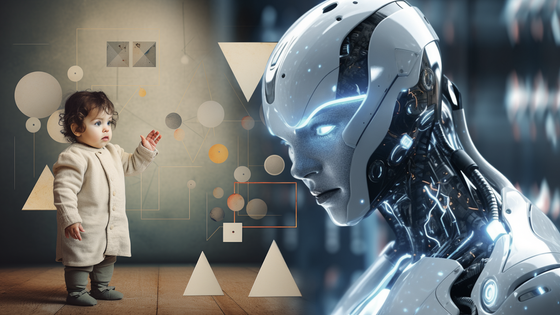We have discontinued our cloud-based data annotation platform since Oct 31st. Contact us for private deployment options.
Before diving into complex patterns, a child must first grasp basic concepts like circles, squares, and triangles to recognize shapes. In much the same way, machines need a method to interpret the data they receive. Machines follow a similar learning curve, requiring a way to decode and understand the data they receive. This is where AI training data comes in.

Machines are like sponges, ready to absorb new information but lacking prior knowledge. To teach them how to distinguish between a cat and a dog or a bicycle and a skateboard, they need exposure to examples and proper guidance.
For instance, suppose you're working on an intelligent security system. One of its core features should be the ability to detect and classify objects and people in its field of view to make smart decisions about potential security risks. AI training data is the key to achieving this goal. It comprises carefully curated and processed information that's fed into the system for learning purposes. The quality of this data can make or break an AI model's performance.
By feeding the machine high-quality training data, it can learn to differentiate between various objects and even subtle differences such as an angry outburst versus a joyous celebration. Training data sets the stage for AI modules, providing machines with fundamental knowledge and allowing them to adapt as they process more information. The outcome is an efficient system that delivers accurate results for end users.
However, it's crucial to note that raw images and videos from the real world can't be used as-is for machine learning. Converting this raw data into usable training data requires careful data labeling and annotation.
What is Data Labeling / Data Annotation?
Data labeling, sometimes referred to as data annotation, has emerged as a booming industry in the AI ecosystem. At its core, data labeling involves human annotators tagging elements within datasets, enabling machine learning algorithms to decipher and learn from the information. These datasets can be either unstructured, sourced from materials like video footage and social media content, or structured, derived from databases. Labeling techniques may include marking, color-coding, or highlighting data to emphasize differences and similarities.

Why is data labeling crucial? It serves as the foundation for teaching AI models to accurately interpret various data formats, such as images, videos, 3D point clouds, audio files, or text. Take, for instance, training a machine to recognize traffic lights. Human annotators meticulously sift through street camera footage and label every traffic light they come across. The machine then digests data from thousands of these annotated images, progressively sharpening its ability to pinpoint traffic lights by processing the annotated data. In a nutshell, data labeling is the secret sauce that helps AI models make sense of the world.
Why Data Annotation is So Important for Computer Vision?
In the realm of machine learning, labeled data is essential for supervised learning, a prevalent approach where algorithms learn from predefined, labeled examples. Data annotation becomes especially indispensable in supervised learning, as the more labeled data the model consumes, the quicker it learns to operate independently. Annotated data empowers AI models to excel in various applications, delivering peak performance and dependable results.

One specialized field within machine learning is computer vision, which focuses on enabling machines to interpret and understand visual information from the world. Deep learning models like convolutional neural networks (CNNs) are designed to mimic the human visual system's processing capabilities, making them particularly suitable for computer vision tasks, such as object detection, facial recognition, and autonomous vehicle navigation. A report on Statista estimates that the machine vision market size in the United States is expected to reach 2.48 billion dollars in 2025, which highlights the growing importance of computer vision technologies.

By leveraging training and testing datasets rich in labeled data, both machine learning and computer vision models can effectively decipher and categorize incoming information. High-quality annotated data is a prerequisite for enabling algorithms to learn autonomously and prioritize outcomes with minimal human intervention. In essence, top-notch data labeling lays the groundwork for smarter, self-sufficient AI and computer vision systems.
Different Data for Computer Vision Annotation
As the field of computer vision continues to advance, a wide variety of data types have emerged to help train models for a multitude of applications. In this section, we'll discuss four main data types used for computer vision annotation: image annotation, video annotation, 3D point cloud annotation, and sensor fusion data annotation.
Image Annotation
Image annotation is perhaps the most common form of data annotation in computer vision. It involves labeling objects or other elements of interest within a 2D image. This can be anything from identifying objects, such as cars or people, to more complex tasks like facial recognition or scene understanding.
Video Annotation
Video annotation takes image annotation a step further by adding a temporal dimension. It involves labeling objects or elements of interest within a sequence of images, typically in the form of a video. This type of annotation is beneficial for tasks that involve motion or tracking, such as pedestrian tracking, vehicle tracking, or action recognition.
3D Point Cloud Annotation
3D point cloud annotation is the process of labeling objects or elements of interest within a 3D point cloud. A point cloud is a collection of data points in a 3D coordinate system, typically obtained from depth sensors or LiDAR scanners. This form of annotation is crucial for tasks that require an understanding of the 3D structure of the scene, such as autonomous driving, robotics, and virtual/augmented reality applications.
Sensor Fusion Data Annotation
Sensor fusion data annotation combines data from multiple sensors, such as cameras, LiDAR, and radar, to create a more comprehensive understanding of the environment. This type of annotation is particularly useful for tasks that require high accuracy and robustness, such as autonomous vehicle perception, where multiple sensor modalities can complement each other and provide a more reliable representation of the surroundings.
Types of Annotation Techniques for Computer Vision Model
Depending on the specific task and data type, various annotation techniques can be employed to train computer vision models. In this section, we'll explore several annotation types commonly used in the field of computer vision.
Bounding Box Annotation | Polygon Annotation |
Bounding box annotation involves drawing a rectangular box around an object or area of interest within an image or video frame. This is a simple and widely-used technique for object detection tasks. | Polygon annotation involves drawing a polygon around an object or area of interest. This method provides more precise annotations compared to bounding boxes, especially for objects with irregular shapes. |
3D Cuboid Annotation | 2D Cuboid Annotation |
3D cuboid annotation is used for annotating objects within a 3D point cloud or sensor fusion data. It involves placing a 3D box around the object of interest, providing both location and size information in the 3D space. | 2D cuboid annotation, also known as "pseudo 3D cuboid", is a technique used to represent objects in a 2D image or video frame as if they were 3D. While it provides a more detailed representation than a simple bounding box, it lacks the precise depth information that a true 3D cuboid annotation would provide. |
Poly-line Annotation | Skeleton Annotation |
Poly-line annotation involves drawing a series of connected line segments to represent an object or area of interest, such as roads, boundaries, or contours. | Skeleton annotation involves annotating the skeletal structure of an object, such as a human body or an animal. This is especially useful for tasks that involve pose estimation or tracking of articulated objects. |
Key Point Annotation | Curve Annotation |
Key point annotation involves marking specific points of interest within an object or scene, such as facial landmarks, joint positions, or object corners. This type of annotation is commonly used for tasks like facial recognition, human pose estimation, and object recognition. | Curve annotation represents annotating curved lines or paths within an image or video frame, such as the trajectory of a moving object or the outline of a curved object. |
Semantic Segmentation | Object Tracking |
Semantic segmentation involves labeling each pixel in an image or video frame with the corresponding object or class label. This technique provides a detailed understanding of the scene and is used for tasks like scene understanding, autonomous driving, and robotics. | Object tracking annotation involves annotating the position and trajectory of moving objects within a video sequence. This type of annotation is essential for tasks that require tracking objects over time, such as pedestrian or vehicle tracking in autonomous driving applications. |
Trends in Data Labeling for Computer Vision Model Training
Automated Annotation Tools: Smart Labeling on the Rise: With the rapid evolution of AI technology, smart data labeling has emerged as a growing trend. Leveraging machine learning and deep learning algorithms, these intelligent annotation tools process and analyze data, enabling automated and efficient data filtering, classification, and labeling. This results in improved labeling efficiency and accuracy.
New and Diverse Applications: Expanding the Horizons of Computer Vision: As computer vision technology progresses, it's increasingly being applied in innovative and diverse domains. These new applications often demand unique or specialized datasets, requiring human expertise for accurate data labeling during the initial stages.
Rare and Imbalanced Classes: The Human Touch for Scarce Data: In many real-world scenarios, specific classes or objects of interest may be occasional or have limited available data. Human data labeling remains essential in ensuring the model can accurately identify and learn from these rare cases, providing precise annotations for these underrepresented classes.
High-Stakes and Safety-Critical Applications: Ensuring Accuracy and Reliability: For applications where errors can have severe consequences, such as autonomous vehicles, medical diagnostics, or surveillance systems, the importance of high-quality annotations is paramount. Human expertise in data labeling will continue to be indispensable for maintaining the highest possible standards of accuracy and reliability.
Complex and Subjective Annotations: Nuanced Insights from Human Intuition: Certain annotation tasks may involve complex or subjective judgments that are challenging for automated systems to handle accurately. For example, understanding the context or emotions within a scene may require human intuition and understanding. In these cases, human data labeling will continue to play a vital role.
Want to Get Your Data Labeled Faster and Better? Contact BasicAI Experts to Get a Quote Today.




